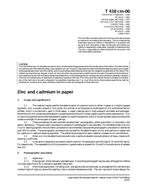Click here to purchase
This method maybe used for the determination of cadmium and zinc either in paper or in highly opaque pigments. Zinc is usually present in zinc oxide, zinc sulfide, or as lithopone (a combination of zinc sulfide and barium sulfate), which is ocassionally used in filled paper, in paper coatings and in high-pressure laminates and wallpaper. Some forms of zinc oxide have photoelectric proper-ties and are found in certain papers used for photo reproduction. Zinc or cadmium pigments are sometimes added to papers to cause fluorescence, and zinc oxide has been used to enhance thecohesive strength of some types of paper coatings.Three procedures for each element are described: polarographic, either gravimetric or volumetric, and atomic absorption. The gravimetric procedure is suitable if a polarograph is not available. For the determination of zinc in a zinc-bearing pigment, the volumetric procedure is recommended, because the polarographic procedure is insensitive over 25% Zn levels. The polarographic procedure can be used for the determination of zinc and cadmiumin paper and for cadmium in cadmium bearing pigments. The preferred procedure for each material is based on its concentration.When zinc is to be determined volu-metrically (cadmium absent) one precipitation of heavy metals with washing is sufficient.In the atomic absorption procedure, sensitivities for 1% absorption are 0.02 mg/mL Zn and 0.03 mg/mL Cd, respectively. The repeatability of this procedure is questionable at present for Zn and Cd concentrations of greater than 5%.
Product Details
- Published:
- 09/13/2006
- Number of Pages:
- 8
- File Size:
- 1 file , 61 KB
